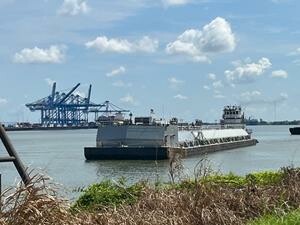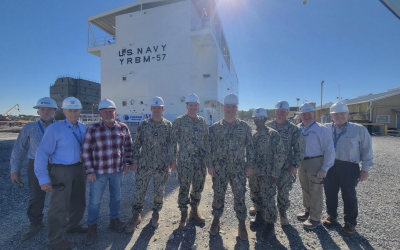Amogy Inc., a pioneer of emission-free, energy-dense ammonia power solutions, has announced a strategic partnership and technology deployment project with Southern Devall, formerly Southern Towing Co. and Devall Towing.
Southern Devall specializes in transporting bulk liquid chemicals and fertilizer products throughout the Mississippi River and Gulf Intracoastal Waterway System.
With the successful integration of Amogy’s technology in a tank barge for the first time, this collaboration with Southern Devall will facilitate the commercial debut of Amogy’s ammonia-to-power technology in the global maritime market.
Southern Devall currently services a significant portion of the ammonia production market and delivers ammonia to terminals for export and agricultural and chemical customers along U.S. inland waterways. Amogy’s proprietary ammonia-to-power system converts ammonia into hydrogen for use in fuel cells or as a more energy dense method of long-distance hydrogen transportation. The system, already demonstrated in a farming tractor and aerial drone, is now being scaled for use in larger applications, including ships and ammonia bunkering barges to support the maritime industry’s decarbonization efforts.
The partnership will provide Amogy with access to vast ammonia infrastructure as well as the Southern Devall team’s expertise in handling ammonia and maritime operations.
Amogy and Southern Devall have initiated work on their first technology deployment, a retrofit of a barge that is anticipated to be completed by the end of 2023. An Amogy powerpack will generate the power needed to reliquefy ammonia as it heats up over the course of a voyage, instead of a diesel genset. The Amogy system will keep the ammonia tank pressure low, enabling Southern Devall to deliver ammonia to customers upon arrival and increase the utilization and profitability of their fleet.
In addition, Amogy’s system has already passed initial safety reviews and recently received Approval in Principle (AiP) from Lloyd’s Register, a maritime classification society, for a powerpack design similar to what the team will look to deploy in this project.
Following the barge integration and demonstration, Amogy and Southern Devall plan to pursue retrofits of additional barges and tugboats, creating an ammonia-powered fleet that includes cargo transportation vessels as well as bunkering barges for efficient, emission-free refueling of ammonia-powered ships.
“Southern Devall shares Amogy’s passion for driving innovation, making them the perfect strategic partner to support our commercial entrance to the U.S. maritime market,” Seonghoon Woo, CEO of Amogy, said in a statement announcing the partnership. “In collaboration with their team, we’ll have a first-mover advantage in this space through expanded access to the ammonia infrastructure and industry knowledge, setting us on track to demonstrate our platform’s operational capabilities in large maritime vessels.”
“Amogy has built an impressive platform that our team believes is an ideal solution for introducing cost-efficient, zero-carbon bunkering and powering operations to the inland barge industry,” said Sam Lewis, vice president of engineering at Southern Devall. “Adopting their solution at scale in our fleet has both environmental and economic benefits through increased delivery volume. We look forward to demonstrating the value of ammonia-to-power solutions in our first project with Amogy and introducing industry and channel partners to these innovations.”
In the U.S., the inland shipping sector is responsible for an estimated 6.2 tons of CO2 emissions each year. Many operators in this industry rely on older, high-investment equipment, vessels and barges dating back to the 1960s. This partnership between Amogy and Southern Devall will demonstrate scalable, cost-effective solutions for refurbishing fleets to improve quality and introduce zero-carbon power and bunkering capabilities.
Current and future projects and demonstrations the companies are pursuing will enable commercialization and broad adoption of ammonia-to-power technologies and keep the industry on track to meet the maritime shipping industry’s goal of cutting greenhouse gas emissions by at least 50% by 2050.





